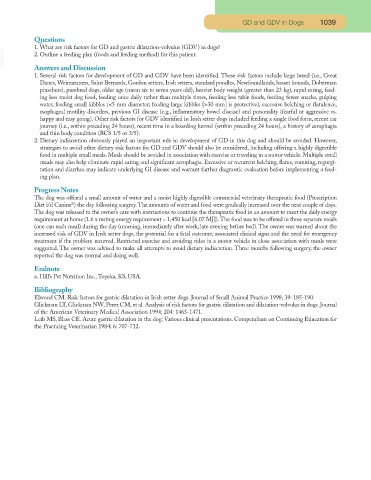Page 1002 - Small Animal Clinical Nutrition 5th Edition
P. 1002
GD and GDV in Dogs 1039
Questions
1. What are risk factors for GD and gastric dilatation-volvulus (GDV) in dogs?
VetBooks.ir 2. Outline a feeding plan (foods and feeding method) for this patient.
Answers and Discussion
1. Several risk factors for development of GD and GDV have been identified. These risk factors include large breed (i.e., Great
Danes, Weimaraners, Saint Bernards, Gordon setters, Irish setters, standard poodles, Newfoundlands, basset hounds, Doberman
pinschers), purebred dogs, older age (mean six to seven years old), heavier body weight (greater than 23 kg), rapid eating, feed-
ing less moist dog food, feeding once daily rather than multiple times, feeding less table foods, feeding fewer snacks, gulping
water, feeding small kibbles (<5 mm diameter; feeding large kibbles [>30 mm] is protective), excessive belching or flatulence,
esophageal motility disorders, previous GI disease (e.g., inflammatory bowel disease) and personality (fearful or aggressive vs.
happy and easy going). Other risk factors for GDV identified in Irish setter dogs included feeding a single food form, recent car
journey (i.e., within preceding 24 hours), recent time in a boarding kennel (within preceding 24 hours), a history of aerophagia
and thin body condition (BCS 1/5 or 2/5).
2. Dietary indiscretion obviously played an important role in development of GD in this dog and should be avoided. However,
strategies to avoid other dietary risk factors for GD and GDV should also be considered, including offering a highly digestible
food in multiple small meals. Meals should be avoided in association with exercise or traveling in a motor vehicle. Multiple small
meals may also help eliminate rapid eating and significant aerophagia. Excessive or recurrent belching, flatus, vomiting, regurgi-
tation and diarrhea may indicate underlying GI disease and warrant further diagnostic evaluation before implementing a feed-
ing plan.
Progress Notes
The dog was offered a small amount of water and a moist highly digestible commercial veterinary therapeutic food (Prescription
a
Diet i/d Canine ) the day following surgery.The amounts of water and food were gradually increased over the next couple of days.
The dog was released to the owner’s care with instructions to continue the therapeutic food in an amount to meet the daily energy
requirement at home (1.6 x resting energy requirement = 1,450 kcal [6.07 MJ]).The food was to be offered in three separate meals
(one can each meal) during the day (morning, immediately after work, late evening before bed). The owner was warned about the
increased risk of GDV in Irish setter dogs, the potential for a fatal outcome, associated clinical signs and the need for emergency
treatment if the problem recurred. Restricted exercise and avoiding rides in a motor vehicle in close association with meals were
suggested. The owner was advised to make all attempts to avoid dietary indiscretion. Three months following surgery, the owner
reported the dog was normal and doing well.
Endnote
a. Hill’s Pet Nutrition Inc., Topeka, KS, USA.
Bibliography
Elwood CM. Risk factors for gastric dilatation in Irish setter dogs. Journal of Small Animal Practice 1998; 39: 185-190.
Glickman LT, Glickman NW, Perez CM, et al. Analysis of risk factors for gastric dilatation and dilatation-volvulus in dogs. Journal
of the American Veterinary Medical Association 1994; 204: 1465-1471.
Leib MS, Blass CE. Acute gastric dilatation in the dog: Various clinical presentations. Compendium on Continuing Education for
the Practicing Veterinarian 1984; 6: 707-712.

